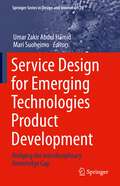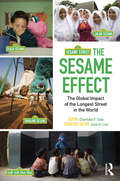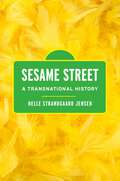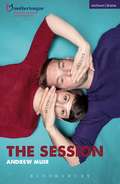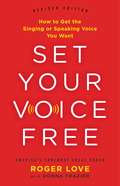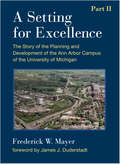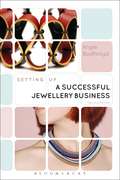- Table View
- List View
The Serpent Column: A Cultural Biography (Onassis Series in Hellenic Culture)
by Paul StephensonThe Serpent Column, a bronze sculpture that has stood in Delphi and Constantinople, today Istanbul, is a Greek representation of the Near Eastern primordial combat myth: it is Typhon, a dragon defeated by Zeus, and also Python slain by Apollo. The column was created after the Battle of Plataia (479 BC), where the sky was dominated by serpentine constellations and by the spiralling tails of the Milky Way. It was erected as a votive for Apollo and as a monument to the victory of the united Greek poleis over the Persians. It is as a victory monument that the column was transplanted to Constantinople and erected in the hippodrome. The column remained a monument to cosmic victory through centuries, but also took on other meanings. Through the Byzantine centuries these interpretation were fundamentally Christian, drawing upon serpentine imagery in Scripture, patristic and homiletic writings. When Byzantines saw the monument they reflected upon this multivalent serpentine symbolism, but also the fact that it was a bronze column. For these observers, it evoked the Temple's brazen pillars, Moses' brazen serpent, the serpentine tempter of Genesis (Satan), and the beast of Revelation. The column was inserted into Christian sacred history, symbolizing creation and the end times. The most enduring interpretation of the column, which is unrelated to religion, and therefore survived the Ottoman capture of the city, is as a talisman against snakes and snake-bites. It is this tale that was told by travellers to Constantinople throughout the Middle Ages, and it is this story that is told to tourists today who visit Istanbul. In this book, Paul Stephenson twists together multiple strands to relate the cultural biography of a unique monument.
The Servant (BFI Film Classics)
by Amy SargeantAmy Sargeant's illuminating study of Joseph Losey's The Servant (1963) provides a detailed discussion of the film's production and reception history, as well as a textual analysis that focuses on Harold Pinter's adaptation of Maugham's novella; the film's use of architecture and interior design to establish character and relationships.
The Servant (BFI Film Classics)
by Amy SargeantAmy Sargeant's compelling and meticulous study of Joseph Losey's The Servant (1963) sets the film in the context of a long tradition of fictional depictions of the master-servant relationship, from Shakespeare to Cervantes, Henry James, Dorothy L. Sayers and P.G. Wodehouse. Sargeant points out that while many of these relationships are played for comic effect, that of the 'young master' Tony (James Fox) and his manservant Barrett (Dirk Bogarde) unfolds in a far more sinister manner, with Barrett coming to dominate and humiliate the hapless Tony.Sargeant's reading pays particular attention to the contribution not only of Losey and Harold Pinter, who adapted the screenplay from Robin Maugham's novella, but also of the cinematographer Douglas Slocombe, designer Richard Macdonald and costume designer Beatrice 'Bumble' Dawson. She analyses the performances of Sarah Miles as Barrett's lover Vera and Wendy Craig as Tony's fiancee Susan, as well as those of Fox and Bogarde, and gives careful consideration to how the film uses architectural form, interior design and decoration, and clothing to establish character and relationships. In the context of the collapse of the British Empire, and a beleaguered Establishment beset by spy and sex scandals, the film can be read, Sargeant argues, as a metaphor for the 'state of the nation' in the early 1960s.Finally, Sargeant considers the film's critical and commercial reception in Britain, Europe and the United States - its release, how it was received as one of a number of 'emigre' films, and Losey's surprising denial of a homoerotic intent in the Tony-Barrett relationship.In her new foreword to this edition, Amy Sargeant considers contemporary resonances of the film's depiction of a twisted master-servant relationship in recent TV and cinema including The Crown, Downton Abbey and The Trial of Christine Keeler.
The Servant (BFI Film Classics)
by Amy SargeantAmy Sargeant's compelling and meticulous study of Joseph Losey's The Servant (1963) sets the film in the context of a long tradition of fictional depictions of the master-servant relationship, from Shakespeare to Cervantes, Henry James, Dorothy L. Sayers and P.G. Wodehouse. Sargeant points out that while many of these relationships are played for comic effect, that of the 'young master' Tony (James Fox) and his manservant Barrett (Dirk Bogarde) unfolds in a far more sinister manner, with Barrett coming to dominate and humiliate the hapless Tony.Sargeant's reading pays particular attention to the contribution not only of Losey and Harold Pinter, who adapted the screenplay from Robin Maugham's novella, but also of the cinematographer Douglas Slocombe, designer Richard Macdonald and costume designer Beatrice 'Bumble' Dawson. She analyses the performances of Sarah Miles as Barrett's lover Vera and Wendy Craig as Tony's fiancee Susan, as well as those of Fox and Bogarde, and gives careful consideration to how the film uses architectural form, interior design and decoration, and clothing to establish character and relationships. In the context of the collapse of the British Empire, and a beleaguered Establishment beset by spy and sex scandals, the film can be read, Sargeant argues, as a metaphor for the 'state of the nation' in the early 1960s.Finally, Sargeant considers the film's critical and commercial reception in Britain, Europe and the United States - its release, how it was received as one of a number of 'emigre' films, and Losey's surprising denial of a homoerotic intent in the Tony-Barrett relationship.In her new foreword to this edition, Amy Sargeant considers contemporary resonances of the film's depiction of a twisted master-servant relationship in recent TV and cinema including The Crown, Downton Abbey and The Trial of Christine Keeler.
Service Design for Emerging Technologies Product Development: Bridging the Interdisciplinary Knowledge Gap (Springer Series in Design and Innovation #29)
by Umar Zakir Abdul Hamid Mari SuoheimoThe productization of emerging technologies related to the Fourth Industrial Revolution (FIR) is now getting more attention across different industries. Compared to the previous industrial transformations that the world has seen which relied on mechanical innovations, the ongoing FIR is seeing software and data-driven products as the foundation. Apart from that, topics such as circular and sustainable economy as well as climate change are also disrupting the industrial ecosystem. For a viable and successful productization of emerging technologies, collaborations between interdisciplinary stakeholders are a necessity. One of the elements that has been identified to facilitate this collaboration is service design. This book aimed to provide comprehensive service design discussions for practitioners in different fields and sectors. The aim is to bridge the knowledge gap between experts in academia, business and product development, among many others, to provide a unified understanding of the importance of service design for the productization of emerging technologies. The book consists of an overview of emerging technologies product development and service design, as well as perspectives from different sectors of the industry. The book is expected to benefit multi-disciplinary researchers, practitioners and general audiences with interests in Service Design for Emerging Technologies.
Serving the Marginalized through Design Education (Routledge Focus on Design Pedagogy)
by Steven B. WebberDesign education and practice are inherently social from process to implementation. This book explores the transformation in design education, as educators prepare their students to address complex social design problems for all people in society.This seven-chapter volume provides the reader with a range of viewpoints on the role of design education in shaping the world. The book begins with the overarching potential of design to address the needs of an increasingly complex society and the importance of worldview that underpins education methodology. Each chapter addresses a context that varies by discipline – architecture, graphic, packaging and interior design – and location – Nigeria, Canada, Lebanon, UK and USA. The authors pull back the curtain on their educational methods and provide the reader with a candid view of their teaching outcomes. The needs of the marginalized – victims of Asian hate, students with dyslexia, tomato farmers and even design students themselves – are brought into focus here. These specific places and peoples provide a design context that can be translated to other situations in design education and practice.Design educators and practitioners of many design disciplines will benefit from the philosophical discussions and the practical education examples offered here. This volume can contribute to transforming design education that will one day transform design practice to place a greater emphasis on the needs of the forgotten in society.
Serving the Marginalized through Design Education (Routledge Focus on Design Pedagogy)
by Steven B. WebberDesign education and practice are inherently social from process to implementation. This book explores the transformation in design education, as educators prepare their students to address complex social design problems for all people in society.This seven-chapter volume provides the reader with a range of viewpoints on the role of design education in shaping the world. The book begins with the overarching potential of design to address the needs of an increasingly complex society and the importance of worldview that underpins education methodology. Each chapter addresses a context that varies by discipline – architecture, graphic, packaging and interior design – and location – Nigeria, Canada, Lebanon, UK and USA. The authors pull back the curtain on their educational methods and provide the reader with a candid view of their teaching outcomes. The needs of the marginalized – victims of Asian hate, students with dyslexia, tomato farmers and even design students themselves – are brought into focus here. These specific places and peoples provide a design context that can be translated to other situations in design education and practice.Design educators and practitioners of many design disciplines will benefit from the philosophical discussions and the practical education examples offered here. This volume can contribute to transforming design education that will one day transform design practice to place a greater emphasis on the needs of the forgotten in society.
The Sesame Effect: The Global Impact of the Longest Street in the World
by Charlotte F. Cole June H. LeeThe Sesame Effect details the wide-ranging work of Sesame Workshop and its productions across the world. With an emphasis on impact and evidence from research on projects in low- and middle-income countries, the book tells the stories behind the development of an international family of Muppet characters created for the locally produced adaptations of Sesame Street. Each chapter highlights the educational message of international co-productions and presents the cultural context of each project. Readers will understand the specific needs of children living in a given locale, as well as gain insight into the educational drivers of each project. These projects often deal with difficult issues, from race relations in the United States, to HIV/AIDS education in South Africa, to building respect across cultural divides in the Middle East. Readers will see how local productions have helped build a new mindset that values the importance of early childhood education, and how Sesame Street promotes a brighter future by building children’s academic skills, encouraging healthy habits, and by fostering attitudes that counter negative stereotypes and create appreciation of and respect for others. The Sesame Effect shows how, when magnified across the millions of children touched by the various international programs, Sesame Workshop and its projects are making a difference around the world.
The Sesame Effect: The Global Impact of the Longest Street in the World
by Charlotte F. Cole June H. LeeThe Sesame Effect details the wide-ranging work of Sesame Workshop and its productions across the world. With an emphasis on impact and evidence from research on projects in low- and middle-income countries, the book tells the stories behind the development of an international family of Muppet characters created for the locally produced adaptations of Sesame Street. Each chapter highlights the educational message of international co-productions and presents the cultural context of each project. Readers will understand the specific needs of children living in a given locale, as well as gain insight into the educational drivers of each project. These projects often deal with difficult issues, from race relations in the United States, to HIV/AIDS education in South Africa, to building respect across cultural divides in the Middle East. Readers will see how local productions have helped build a new mindset that values the importance of early childhood education, and how Sesame Street promotes a brighter future by building children’s academic skills, encouraging healthy habits, and by fostering attitudes that counter negative stereotypes and create appreciation of and respect for others. The Sesame Effect shows how, when magnified across the millions of children touched by the various international programs, Sesame Workshop and its projects are making a difference around the world.
Sesame Street: A Transnational History
by Helle Strandgaard JensenIn Sesame Street: A Transnational History, author Helle Strandgaard Jensen tells the story of how the American television show became a global brand. Jensen argues that because the show's domestic production was not financially viable from the beginning, Sesame Street became a commodity that its producers assertively marketed all over the world. Sesame Street: A Transnational History combines archival research from seven countries, bolstering an insightful analysis of how local reception and rejection of the show related to the global sales strategies and American ideals it was built upon. Contrary to the producers' oft-publicized claims of Sesame Street's universality, the show was heavily shaped by a fixed set of assumptions about childhood, education, and commercial entertainment. This made sales difficult as Sesame Street met both skepticism and direct hostility from foreign television producers who did not share these ideals. Drawing on insights from new histories about childhood, education, and transnational media, the book lays bare a cultural clash of international proportions rooted in divergent approaches to children's television. In doing so, it provides a reflective backdrop to the many ongoing debates about children's media. In contrasting the positive receptions and renunciations of Sesame Street, Jensen demonstrates that it was only after a substantial rethinking of Sesame Street's aims and business model that this program ended up on numerous broadcasting schedules by the mid-1970s. Along the way, this rethinking and the constant negotiations with potential international buyers created and shaped the business and corporate brand that paved the way for the Sesame Street we know today.
The Session (Modern Plays)
by Andrew MuirOne minute I'm in The Elk watching the footie the next minute I'm at the beach with a Polish supermodel. Fucking come on.Lena meets Robbie. Girl meets Boy. Head over heels. Eyes only for each other. They don't speak the same language, but they both know the language of love, and surely that's enough for a while – until the unspeakable happens and the truth comes spewing out. As their marriage hurtles towards oblivion, Lena and Robbie desperately attempt to find a common language and save their shared history.The Session is a heartfelt play about how couples communicate, taking in twenty years of a relationship that is based on misunderstanding and crossed wires. It received its world premiere at Soho Theatre on 3 November 2015.
The Session (Modern Plays)
by Andrew MuirOne minute I'm in The Elk watching the footie the next minute I'm at the beach with a Polish supermodel. Fucking come on.Lena meets Robbie. Girl meets Boy. Head over heels. Eyes only for each other. They don't speak the same language, but they both know the language of love, and surely that's enough for a while – until the unspeakable happens and the truth comes spewing out. As their marriage hurtles towards oblivion, Lena and Robbie desperately attempt to find a common language and save their shared history.The Session is a heartfelt play about how couples communicate, taking in twenty years of a relationship that is based on misunderstanding and crossed wires. It received its world premiere at Soho Theatre on 3 November 2015.
Set Lighting Technician's Handbook: Film Lighting Equipment, Practice, and Electrical Distribution
by Harry BoxComprehensive. Detailed. Practical. Set Lighting Technician's Handbook, Fourth Edition, is a friendly, hands-on manual covering the day-to-day practices, equipment, and tricks of the trade essential to anyone doing motion picture lighting, including the lamp operator, rigging crew, gaffer, best boy, or director of photography. This handbook offers a wealth of practical technical information, useful techniques, as well as aesthetic discussions. The Set Lighting Technician's Handbook focuses on what is important when working on-set: trouble-shooting, teamwork, set protocol, and safety. It describes tricks and techniques for operating a vast array of lighting equipment including LEDs, xenons, camera synchronous strobes, black lights, underwater units, lighting effects units, and many others. Since its first edition, this handy on-set reference continues to be widely adopted as a training and reference manual by union training programs as well as top university film production programs. New to the fourth edition:* Detailed information on LED technology and gear* Harmonized with union safety and training procedures* All the latest and greatest DMX gadgets, including remote control systems* Many new and useful lights and how to use them and troubleshoot them.* New additions to the arsenal of electrical distribution equipment that make our sets safer and easier to power.* More rigging tricks and techniques.* the same friendly, easy to read style that has made this book so popular.
Set Lighting Technician's Handbook: Film Lighting Equipment, Practice, and Electrical Distribution
by Harry BoxComprehensive. Detailed. Practical. Set Lighting Technician's Handbook, Fourth Edition, is a friendly, hands-on manual covering the day-to-day practices, equipment, and tricks of the trade essential to anyone doing motion picture lighting, including the lamp operator, rigging crew, gaffer, best boy, or director of photography. This handbook offers a wealth of practical technical information, useful techniques, as well as aesthetic discussions. The Set Lighting Technician's Handbook focuses on what is important when working on-set: trouble-shooting, teamwork, set protocol, and safety. It describes tricks and techniques for operating a vast array of lighting equipment including LEDs, xenons, camera synchronous strobes, black lights, underwater units, lighting effects units, and many others. Since its first edition, this handy on-set reference continues to be widely adopted as a training and reference manual by union training programs as well as top university film production programs. New to the fourth edition:* Detailed information on LED technology and gear* Harmonized with union safety and training procedures* All the latest and greatest DMX gadgets, including remote control systems* Many new and useful lights and how to use them and troubleshoot them.* New additions to the arsenal of electrical distribution equipment that make our sets safer and easier to power.* More rigging tricks and techniques.* the same friendly, easy to read style that has made this book so popular.
Set Lighting Technician's Handbook: Film Lighting Equipment, Practice, and Electrical Distribution
by Harry C. BoxA friendly, hands-on training manual and reference for lighting technicians in motion picture and television production, this handbook is the most comprehensive guide to set lighting available. It provides a unique combination of practical detail with a big-picture understanding of lighting, technology, safety, and professionalism, essential to anyone doing motion picture lighting. The fifth edition delves into every aspect of lighting and features vastly expanded sections on controlling LED lights, color science, lighting control systems, wireless systems, Ethernet-based control systems, battery power, and modern set protocol for productions small and large. With a generous number of original images, the book illustrates the use of soft light, the effect of lighting angles, and how the gaffer and DP build an effective lighting plan around the blocking of the actors. This encyclopedic volume of technical knowhow is tempered with years of practical experience and a much-needed sense of humor.This is the ideal text for professional lighting technicians across film and television including lighting directors, gaffers, DOPs, and rigging crews, as well as film and television production students studying lighting, camera techniques, film production, and cinematography.It includes a revamped companion website with supplementary resources, forms, checklists, and images.
Set Lighting Technician's Handbook: Film Lighting Equipment, Practice, and Electrical Distribution
by Harry C. BoxA friendly, hands-on training manual and reference for lighting technicians in motion picture and television production, this handbook is the most comprehensive guide to set lighting available. It provides a unique combination of practical detail with a big-picture understanding of lighting, technology, safety, and professionalism, essential to anyone doing motion picture lighting. The fifth edition delves into every aspect of lighting and features vastly expanded sections on controlling LED lights, color science, lighting control systems, wireless systems, Ethernet-based control systems, battery power, and modern set protocol for productions small and large. With a generous number of original images, the book illustrates the use of soft light, the effect of lighting angles, and how the gaffer and DP build an effective lighting plan around the blocking of the actors. This encyclopedic volume of technical knowhow is tempered with years of practical experience and a much-needed sense of humor.This is the ideal text for professional lighting technicians across film and television including lighting directors, gaffers, DOPs, and rigging crews, as well as film and television production students studying lighting, camera techniques, film production, and cinematography.It includes a revamped companion website with supplementary resources, forms, checklists, and images.
Set Your Voice Free: How to Get the Singing or Speaking Voice You Want
by Roger Love Donna FrazierEvery time we open our mouths, we have an effect on ourselves and the way others perceive us. The ability to speak clearly and confidently can make or break a presentation, an important meeting, or even a first date. Now, with the advent of Skype, YouTube, podcasting, Vine, and any number of reality talent competitions, your vocal presence has never been more necessary for success or more central to achieving your dreams. Roger Love has over 30 years of experience as one of the world's leading authorities on voice. Making use of the innovative techniques that have worked wonders with his professional clients, Love distills the best of his teaching in Set Your Voice Free, and shares exercises that will help readers bring emotion, range, and power to the way they speak. This updated edition incorporates what he's learned in the last 15 years as the Internet and talent competitions have completely changed the role your voice plays in your life. These are the new essentials for sounding authentic, persuasive, distinctive, and real in a world that demands nothing less.
A Setting For Excellence: The Story of the Planning and Development of the Ann Arbor Campus of the University of Michigan
by Frederick W MayerWhile there are times when the mix of old and new buildings and the chaotic activities of thousands of students can give a haphazard appearance to the university, campus planning has in fact become a highly refined form of architecture. This is demonstrated in a convincing fashion by this immensely informative and entertaining history of the evolution of the campuses of the University of Michigan by Fred Mayer, who served for more than three decades as the campus planner for the university during an important period of its growth during the late twentieth century. By tracing the development of the Michigan campus from its early days to the present, within the context of the evolution of higher education in America, Mayer provides a strong argument for the importance of rigorous and enlightened campus planning as a critical element of the learning environment of the university. His comprehensive history of campus planning, illustrated with photos, maps, and diagrams from Michigan’s history, is an outstanding contribution to the university’s history as it approaches its bicentennial in 2017. Perhaps more important, Mayer’s book provides a valuable treatise on the evolution of campus planning as an architectural discipline.
A Setting For Excellence, Part II: The Story of the Planning and Development of the Ann Arbor Campus of the University of Michigan
by Frederick W MayerCampus planning is often a crucial underlying set of goals for university administrations, even if, over time, the mix of new and old buildings, changes in usage patterns and activities of students, and evolution of styles present challenges to a cohesive campus plan. In its two-hundred year history the University of Michigan has planned its campus in waves, from the earliest days of the iconic buildings around the Diag to the plans for the hospitals and the North Campus. This immensely informative and entertaining second volume in the history of the evolution of the campuses offers an absorbing narrative from the perspective of Fred Mayer, who served for more than three decades as the campus planner for the university during an important period of its growth during the late twentieth century. By tracing the development of the Ann Arbor campus from its early days to the present, within the context of the evolution of higher education in America, Mayer provides a strong argument for the importance of rigorous and enlightened campus planning as a critical element of the learning environment of the university. His comprehensive history of campus planning, illustrated with photos, maps, and diagrams from Michigan’s history, is an outstanding contribution to the university’s history as it approaches its bicentennial.
Setting the Scene: Perspectives on Twentieth-Century Theatre Architecture
by Alistair FairDuring the twentieth century, an increasingly diverse range of buildings and spaces was used for theatre. Theatre architecture was re-formed by new approaches to staging and performance, while theatre was often thought to have a reforming role in society. Innovation was accompanied by the revival and reinterpretation of older ideas. The contributors to this volume explore these ideas in a variety of contexts, from detailed discussions of key architects’ work (including Denys Lasdun, Peter Moro, Cedric Price and Heinrich Tessenow) to broader surveys of theatre in West Germany and Japan. Other contributions examine the Malmö Stadsteater, ’ideal’ theatres in post-war North America, ’found space’ in 1960s New York, and Postmodernity in 1980s East Germany. Together these essays shed new light on this complex building type and also contribute to the wider architectural history of the twentieth century.
Setting the Scene: Perspectives on Twentieth-Century Theatre Architecture
by Alistair FairDuring the twentieth century, an increasingly diverse range of buildings and spaces was used for theatre. Theatre architecture was re-formed by new approaches to staging and performance, while theatre was often thought to have a reforming role in society. Innovation was accompanied by the revival and reinterpretation of older ideas. The contributors to this volume explore these ideas in a variety of contexts, from detailed discussions of key architects’ work (including Denys Lasdun, Peter Moro, Cedric Price and Heinrich Tessenow) to broader surveys of theatre in West Germany and Japan. Other contributions examine the Malmö Stadsteater, ’ideal’ theatres in post-war North America, ’found space’ in 1960s New York, and Postmodernity in 1980s East Germany. Together these essays shed new light on this complex building type and also contribute to the wider architectural history of the twentieth century.
Setting Up a Successful Jewellery Business
by Angie BoothroydAn updated edition of the best-selling handbook, this all-encompassing guide for jewellery entrepreneurs of all levels covers key lessons for setting up, running and growing a jewellery business.From the college graduate looking to set up a workshop, to the established maker ready to expand their business, Setting up a Successful Jewellery Business equips creative jewellers with the essential knowledge and tools to operate a professional jewellery business.Encouraging individuals to define their business objectives and strategy for the future, the guide deals with topics including:· presenting your brand;· protecting your designs;· how much to charge for your work;· selling to shops, galleries and individuals;· creating your website and driving traffic to it;· managing your time and finances plus other essential business skills.Updated with two new chapters, an expanded section on social media and a revised appendix, this is an indispensable jeweller's companion that provides the resources to take your business forward.
Setting Up a Successful Jewellery Business
by Angie BoothroydAn updated edition of the best-selling handbook, this all-encompassing guide for jewellery entrepreneurs of all levels covers key lessons for setting up, running and growing a jewellery business.From the college graduate looking to set up a workshop, to the established maker ready to expand their business, Setting up a Successful Jewellery Business equips creative jewellers with the essential knowledge and tools to operate a professional jewellery business.Encouraging individuals to define their business objectives and strategy for the future, the guide deals with topics including:· presenting your brand;· protecting your designs;· how much to charge for your work;· selling to shops, galleries and individuals;· creating your website and driving traffic to it;· managing your time and finances plus other essential business skills.Updated with two new chapters, an expanded section on social media and a revised appendix, this is an indispensable jeweller's companion that provides the resources to take your business forward.
Setting up a Successful Photography Business
by Lisa PritchardSetting up a Successful Photography Business is a practical and essential handbook for anyone who wants to be a professional photographer. Written by the owner of a successful photography agency, it is packed full of helpful information and invaluable advice from not only the author but also many leading photographers and commissioners working in all areas of the industry today. This book includes all the essentials- how to prepare the best portfolio and website; how to market yourself and get clients; how to cost and produce shoots; how to find representation; how to finance and run your business; how to deal with contracts and legal obligations plus much more. It also contains lots of useful checklists, charts and handy business templates- everything you need to know to get your own photography business off to flying start.
Setting up a Successful Photography Business: How To Be A Professional Photographer
by Lisa PritchardSetting up a Successful Photography Business is a practical and essential handbook for anyone who wants to be a professional photographer. Written by the owner of a successful photography agency, it is packed full of helpful information and invaluable advice from not only the author but also many leading photographers and commissioners working in all areas of the industry today. This book includes all the essentials- how to prepare the best portfolio and website; how to market yourself and get clients; how to cost and produce shoots; how to find representation; how to finance and run your business; how to deal with contracts and legal obligations plus much more. It also contains lots of useful checklists, charts and handy business templates- everything you need to know to get your own photography business off to flying start.



